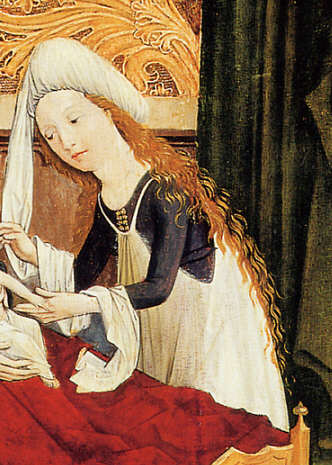So it is done, my new smocked shift. This time I tried hard not to make a neckline that scoops too low, a thing I always manage to do with my shifts. It took a few times of pinning, trying it on, repin it and repeat.
The inspiration is mainly the finely smocked shifts and shirts from really late 15th C Germany, such as Dürers shirt, and I looked into the larger number of extant Italian camicias of the 16th C for the cut and also decorations. Here are one example of the sleeve and gusset that I liked:
I did however choose a different layout of the gusset since I did not want to much fabric to gather in the armpit of my rather slimfitted kirtlesleeves. Another great inspiration is the shift of Mary of Hungary, ca 1520:
When I displayed my last smocked shift (read about it here: http://www.renikasanachronisticadventures.blogspot.se/2013/04/all-dressed-up-housebook-style.html), I did get the question why I had made such big and coarse pleats in the neck insert. I thought about it and figured I was just taking the easy path and thus challenged myself a bit this time. So I made the pleats so tiny I had problems getting them to form, and got the tip on damping the fabric and then gently pull in the direction of the pleats, and the linen gently pleated itself.
One of the main reasons for making this rather plain shift with a simple white smock was that I wanted to use the lovely antique golden lace I got from my mother in law, forming the edging of a lovely but really worn brocade table cloth. And there are some extant camicias with golden lace on the edge, excellent inspiration:
And this is how it turned out, with a side gore inserted and replacing the armpit square gore. The cuffs are plain and simple, since they will not be showing at all.
It took some effort to get the bias sewn to the smocking on the neckline and then attaching the lace, but I do think it was worth every minute and every pricked finger, this will for sure be a well used smock.
First I pinned the bias strip over the smocking, trying not to stretch it too much.
Then I sew the bias down over the edge, thus forming a firm edging for support of the rather heavy golden lace.
The lace was pinned on and then sewn with a fine brown silk, that does not contrast too much to the rather old looking lace.
måndag 25 november 2013
söndag 10 november 2013
Pretty protection
For my apron I decided to gather pleats on top front and back, and the fabric I used is not pure white as in most depictions, but striped with thin black stripes. But I decided not to be to true to the originals but to make my own interpretation. It turned out to be a bigger project than I had imagined, mainly because my stubborn decision to pleat it so much. But the result was worth it and I will be proud to wear it at our next upcoming local event, where I will be head cook.
The weather could have been better but here I am, standing in a rather cold November rain, in the Housebook dress, the new smock that is almost done and the apron. I was afraid that I would have to shorten the shoulder straps, but it worked just fine. I bought the fabric from my favourite Polish merchants at the Medieval market in August, it is a rather fine linen with black stripes and I just loved it at first sight. I sew it with flax thread and the smock is sewn with a rather heavy black silk, reinforced in the back with similar seams in flax.


The cut is really simple, I think it ought to be two rectangular pieces, just gathered at the top and sewn together in the sides, but I found it hard to get the smocked part as thin as I wanted it so I simply cut it into two trapezoid shapes. The top part I gathered with a smocking thread and then I sew right across the pleats with the black silk, reinforcing the back with similar seams, approximately two centimeters apart.
Prenumerera på:
Inlägg (Atom)











